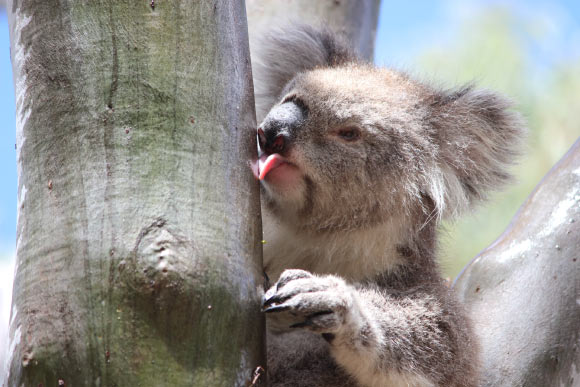A team of Australian scientists and wildlife ecologists has captured koala drinking behavior in the wild for the first time.

Old female koala showing natural drinking behavior after a rain event in the You Yang Regional Park, Victoria, Australia. Image credit: Echidna Walkabout / Koala Clancy Foundation.
Each day, wild koalas (Phascolarctos cinereus) eat around 510 grams of fresh eucalyptus leaves, and the water in the foliage they feed on is believed to contribute about 75% of their water intake in both summer and winter.
Among their adaptations to the Australian climate, they also possess extraordinary urinary concentrating abilities and have restricted respiratory and cutaneous water loss compared to similar-sized mammals.
In captivity, koalas have been observed to drink water, but this behavior has often been considered unusual and attributed to disease or to severe heat stress.
However, anecdotal reports suggest that koalas in the wild drink from waterholes in summer when temperatures exceed 40 degrees Celsius (104 degrees Fahrenheit).
Koalas have also been observed approaching humans to access free water: in bottles, gardens and swimming pools during drought and after fire; but this is considered an unusual occurrence.
“For a long time, we thought koalas didn’t need to drink much at all because they gained the majority of the water they need to survive in the gum leaves they feed on,” said team leader Dr. Valentina Mella, a researcher in the School of Life and Environmental Sciences at the University of Sydney.
“But now we have observed them licking water from tree trunks. This significantly alters our understanding of how koalas gain water in the wild. It is very exciting.”
For the study, Dr. Mella and colleagues collated observations of koalas drinking in the wild made by citizen scientists and independent ecologists between 2006 and 2019 at the You Yangs Regional Park, Victoria, Australia.
There were 44 observations of free ranging koalas licking water running down a tree trunk during or immediately after rain.
The other two observations of koala drinking behavior were recorded between the towns of Gunnedah and Mullaley, in the Liverpool Plains: one was an adult female, with a joey, who drank profusely and uninterruptedly for 15 minutes; the other was an adult male who drank at a steady pace for 34 minutes.
“As koalas are nocturnal animals and observation of their behavior rarely occurs during heavy rainfall, it is likely that their drinking behavior has gone largely unnoticed and has therefore been underestimated in the past,” Dr. Mella said.
“Our observations probably only represent a minority of the drinking that normally takes place in trees during rainfall.”
Koalas were observed accessing water in trees by licking the wet surfaces of branches and tree trunks during rain across a range of weather conditions, even when free-standing water was available in dams.
“This suggests koalas were drinking not as a result of heat stress and that this behavior is likely to represent how koalas naturally access water,” Dr. Mella concluded.
The team’s paper was published in the journal Ethology.
_____
Valentina S.A. Mella et al. An insight into natural koala drinking behaviour. Ethology, published online May 2, 2020; doi: 10.1111/eth.13032







